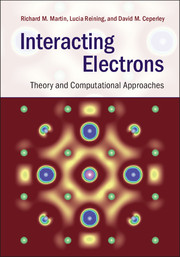Book contents
- Frontmatter
- Dedication
- Contents
- Preface
- Acknowledgments
- Notation
- Part I Interacting electrons: beyond the independent-particle picture
- Part II Foundations of theory for many-body systems
- Part III Many-body Green's function methods
- 9 Many-body perturbation theory: expansion in the interaction
- 10 Many-body perturbation theory via functional derivatives
- 11 The RPA and the GW approximation for the self-energy
- 12 GWA calculations in practice
- 13 GWA calculations: illustrative results
- 14 RPA and beyond: the Bethe–Salpeter equation
- 15 Beyond the GW approximation
- 16 Dynamical mean-field theory
- 17 Beyond the single-site approximation in DMFT
- 18 Solvers for embedded systems
- 19 Characteristic hamiltonians for solids with d and f states
- 20 Examples of calculations for solids with d and f states
- 21 Combining Green's functions approaches: an outlook
- Part IV Stochastic methods
- Part V Appendices
- References
- Index
11 - The RPA and the GW approximation for the self-energy
from Part III - Many-body Green's function methods
Published online by Cambridge University Press: 05 June 2016
- Frontmatter
- Dedication
- Contents
- Preface
- Acknowledgments
- Notation
- Part I Interacting electrons: beyond the independent-particle picture
- Part II Foundations of theory for many-body systems
- Part III Many-body Green's function methods
- 9 Many-body perturbation theory: expansion in the interaction
- 10 Many-body perturbation theory via functional derivatives
- 11 The RPA and the GW approximation for the self-energy
- 12 GWA calculations in practice
- 13 GWA calculations: illustrative results
- 14 RPA and beyond: the Bethe–Salpeter equation
- 15 Beyond the GW approximation
- 16 Dynamical mean-field theory
- 17 Beyond the single-site approximation in DMFT
- 18 Solvers for embedded systems
- 19 Characteristic hamiltonians for solids with d and f states
- 20 Examples of calculations for solids with d and f states
- 21 Combining Green's functions approaches: an outlook
- Part IV Stochastic methods
- Part V Appendices
- References
- Index
Summary
Besides the proof of a modified Luttinger–Ward–Klein variational principle and a related self-consistency idea, there is not much new in principle in this paper.
L. Hedin, Phys. Rev. 139, A796–823 (1965)Summary
In this chapter a set of equations is formulated that determine the self-energy and the one-body Green's function in terms of the screened Coulomb interaction between classical charges. The equations contain a correction to the classical picture in terms of a vertex function. The physical meaning of the various contributions is discussed. The simplest approximation for the vertex yields the random phase approximation for the polarizability and the GW approximation for the self-energy. Various aspects of the GWA are analyzed, with a focus on the physics that is added beyond Hartree– Fock. A brief summary of model cases illustrates the domain of validity and the limits of the GWA.
In this chapter we elaborate in more detail on the question of how to calculate the onebody Green's function from a Dyson equation with a self-energy kernel. In the previous chapter a scheme was introduced to design approximations to the self-energy. However, the question of where to stop, which pieces of physics to include and which to neglect, is not yet settled. Of course, there is no unique answer, besides the exact solution, but different strategies can be more or less advantageous in practice. In a system with a few electrons, for example, different aspects will be important than in a system with many electrons.
Here we are mostly interested in solids, or more generally in extended systems. In such systems, screening plays an essential role: the interaction between two charges is strongly modified, in general reduced, by the rearrangement of all the other charges. It is therefore most convenient to reformulate the equations such that screening appears explicitly. Some steps in this direction can be found in earlier chapters, in particular in Sec. 8.3, the formulation of the Ψ [G,W]-functional of the screened interaction W instead of the Ф[G, vc]-functional of the bare vc. In Sec. 10.5 the screened interaction approximation for the self-energy is derived, with the self-energy as a product of the one-body Green's function and the screened interaction W.
- Type
- Chapter
- Information
- Interacting ElectronsTheory and Computational Approaches, pp. 245 - 279Publisher: Cambridge University PressPrint publication year: 2016



